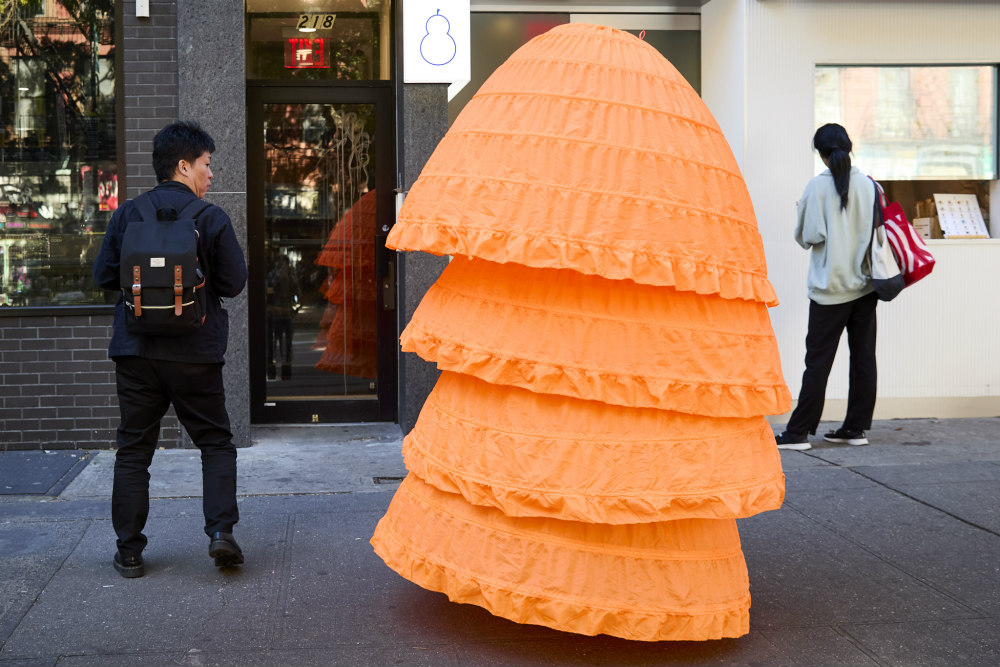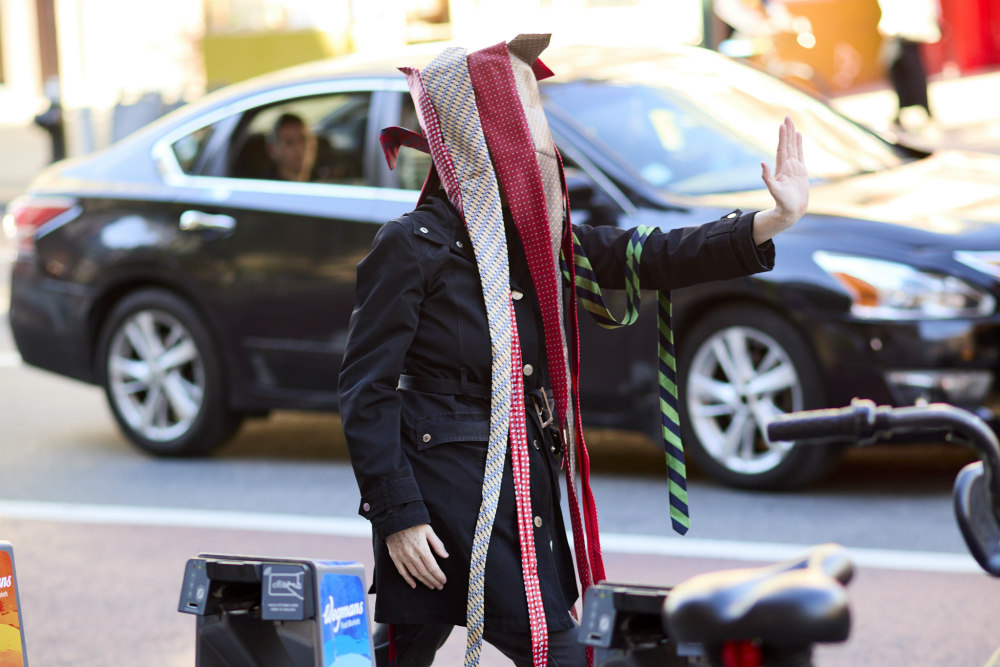For one glorious, magical weekend a year, 14th Street in Manhattan becomes a gallery “bringing art off the wall and into public space,” says artist and curator Gretchen Vitamvas. Art in Odd Places is more than an art festival. It activates public engagement and infuses energy along 14th Street from east to west, like windchimes coated in glitter in the midst of a hailstorm.
Its fierceness is channeled from creative minds that bring engaging concepts to the public in unique forms, interspersed throughout the expanse. It celebrates the weird, champions queerness, and acknowledges the significance of artists as essential fibers in this complex societal structure. When Art in Odd Places started as an action by a group of artists led by artist Ed Woodham, twenty-seven years ago, this subversive and provocative project encouraged local participation in the Cultural Olympiad of the 1996 Olympics in Atlanta.
After moving to New York, Woodham re-imagined the festival “as a response to the dwindling of public space and personal civil liberties – first in the Lower East Side and East Village, and since 2008, on 14th Street in Manhattan.” Since then, it has grown tentacles throughout its extraordinary evolution.
Art in Odd Places has been produced in other US cities as well as Saint Petersburg, Russia, and Sydney, Australia and was selected as a representative in the U.S. Pavilion, Spontaneous Interventions: Design Actions for the Common Good at the Venice Architecture Biennale in 2012. But it has always been a grassroots project fueled by the goodwill and inventiveness of its participants. They define their mission as a way to “stretch the boundaries of communication in the public realm by presenting artworks in all disciplines outside the confines of traditional public space regulations.”

Woodham tells me that he has had the incredible opportunity to dedicate his creative practice to observing the public sphere of New York City and more recently other cities and suburban municipalities. “I’ve watched the incremental shift of personal space in the urban out-of-doors. Like in the beginning, I thought it was important to create collective actions based on the ideology that public space is, where we democratically communicate ideas for change,” says Woodham. And he adds, “Art in Odd Places is a model for making a substantial cultural impact without capital but instead with sincere generosity and curiosity.”
In previous years, the art presented in public space has taken the form of performances, installations, fashion shows, poetry readings, a mobile gallery of invisible sculptures, video screenings, the care and repair of damaged sidewalks, gold spray-painted bags of garbage adorning the streets, miniature puppet shows, and more. Last weekend 14th Street became a runway.
This year’s art interventions under the theme ‘DRESS’ reflect on the fact that every time we get dressed, it is also a way for urban dwellers to interact with each other in the public space. That simple act has consequences with regard to each other’s judgements about gender, class, work, lifestyle, social group, and cultural heritage based on appearance. “Our clothing communicates information about our work, activities and aspirations. Dress can be prescribed or intentionally personal. It can be practical, protecting our bodies from the weather or worksite; or fanciful, making a statement. We dress to provoke, to go unnoticed, to align with a social group, to conform (whether by choice or requirement), to challenge, to fit in, to be admired, to aspire, to protest, and to express identity,” reads this year’s manifesto for the festival.

Art in Odd Places: DRESS curator Gretchen Vitamvas shares, “Ahead of choosing the word ‘DRESS’ as the festival theme, Ed and I discussed how we both loved the idea of 14th Street as a runway. I know that runway presentation was an early project for Ed when he was living in Atlanta…and we decided to look for a prompt that would encourage this direction for the festival….I love that dress as a medium for expression is immediately relatable to a viewer as it contains or relates to the body. It invites us in by utilizing familiar social cues and the ritual of applying the exterior with which we face the world… DRESS also felt like the right word for the moment especially given the current political backlash against trans people, drag story hours, non-binary presentation.”
The artists walk the runway on 14th Street exploring themes such as clothing production and colonialism, fast fashion and waste, transformation and gender identity (and intolerance), cultural identity, work and labor, censorship, the passage of time and its traces, beauty, disability, status, armor, joy and grief. The same Sidewalk Runway is activated for all New Yorkers who are invited to walk the catwalk, pose and show their style, complete with an emcee and paparazzi.

Additionally, the artists installed work on sidewalks, paraded in fabulous wearable art that offers space to contemplate, question, and reflect on what is happening around us; including the ongoing culture wars in the United States. Micki Watanabe Spiller’s intervention “Banned Book Banditos” took form as a group of “reading outlaws”. Emulating the concept of the spaghetti western, the group organized by the artist marched to Ennio Morricone’s music, dressed in beautifully embroidered bandoliers, western hats and boots, armed with literary classics that have made their way onto banned book lists. The action included the handing out of pocket-sized zines, which are richly packed with information and reinforce the understanding that knowledge is power.
In the same manner, MiSWiP’s “Let’s Make an Outfit” considers the oppressive ideologies that target drag and trans rights, as well as the fashion industry’s impact on the environment through the act of dressing and undressing on the sidewalk. The project installation of Melissa Lockwood focused on raising awareness about a method she developed that has the potential to lower fashion industry landfill waste significantly, a theme that designers in African cities are also trying to address.
The act of thinking-out-loud takes hold of passersby through the reading of labels and painstakingly hand-embroidered facts that are literally woven into the fabric of both art objects and contemporary American culture. Metal construction poles holding up scaffolding are transformed into a stage; and the intimacy of the dressing room is on public display, to engage the public in conversation and awareness in a quest for positive change.
Another collective, Garbagia (project title the same name) takes to the streets adorned in futuristic costumes composed of recyclable objects. Inspired by fellow Lower East Side artist Rolando Politi, whose work is displayed throughout the neighborhood, including La Plaza Cultural Community Garden, brings the issue of mass consumption to the forefront with ultimate style and flair.

As always, the nature of this art festival in public space challenges the status quo and engages the public in important ways, asking passersby to determine: “what is art; how is it addressing current issues, and in what ways is art addressing those issues outside of traditional frameworks?”
Woodham’s mission is more important now than ever before. “We see the rise of ignorance, the fear of change, and the realization that the white patriarchal institutions and corporations are not going to let go of their control without a fight,” he says. Art in Odd Places is a celebration that welcomes and creates a place of belonging despite what else is happening around it that “comes from the collective generosity of everyone involved in the act of creating and mindfully sharing ideas.” The proceeds of this year’s events go to support the cause of the NYC Anti-Violence Project (AVP) in New York.
If the role of art is to challenge and expand one’s purview, then this vision of Art in Odd Places does so fluidly and elastically, with all the pomp and circumstance one would find at a parade in public space, but without the dull, bureaucratic red tape that keeps creativity on a short leash.
This year’s AiOP team, includes Ed Woodham, founder and director of AiOP; Gretchen Vitamvas, curator; Sarah Starpoli, Curatorial Manager; Tasha Dougé, Curatorial Assistant; Michelle Leidecker, Volunteer Coordinator; Tianqi (Angela) Liao, Photography and Video Manager; Aga Sablinska, Press Manager; Flora Lin, Social Media Manager; Laurie Waxman, Graphic Designer; and Ross Mabbett, Web Developer.




